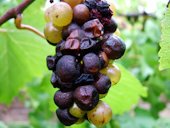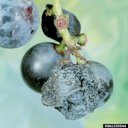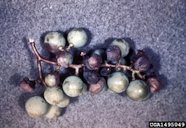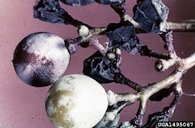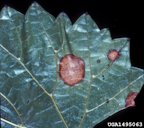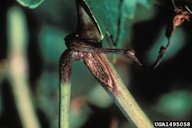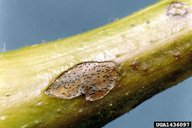| Grape Diseases | ||||||||||||||||
|---|---|---|---|---|---|---|---|---|---|---|---|---|---|---|---|---|
| Back
to Muscadine Grape Page Bunch Grape Page 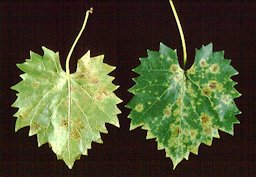 Fig. 1 Angular leaf spot on muscadine grape, caused by the fungus Mycosphaerella angulata 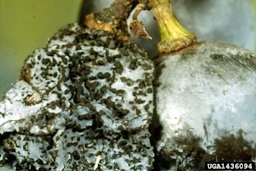 Fig. 2  Bitter Rot caused by Greeneria uvicola 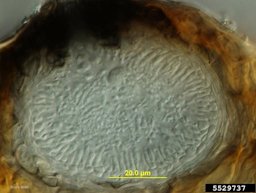 Fig. 5  Fruiting bodies of black rot 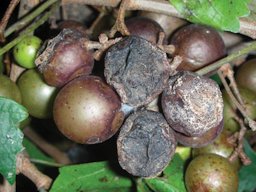 Fig. 11  Berry rot and collapse as a result of ripe rot. Note the pink color of the fungal growth and spores on the surface of several of the berries. 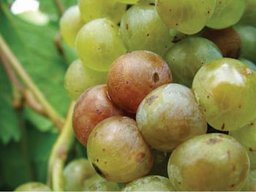 Fig. 12 Symptoms of Macrophoma rot on berries 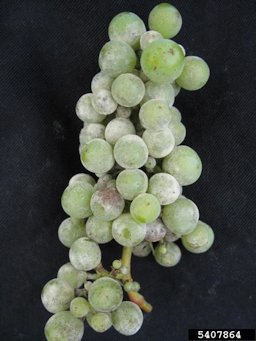 Fig. 13  Berries in a grape bunch covered with the white powdery fungal growth of Uncinula necator (powdery mildew)
|
The
most common diseases on muscadine grape berries and/or leaves are
angular leaf spot, black rot, ripe rot, macrophoma rot and powdery
mildew. Bitter rot can infect all above ground tissue. 1 Angular Leaf Spot Mycosphaerella angulata Angular leaf spot (M. angulata) is a disease that only attacks the foliage and may cause premature leaf drop. This disease appears as angular, dark brown spots surrounded by a halo. Premature leaf loss can result in increased levels of vine stress that may reduce fruit quality and vine longevity. 1 Bitter Rot Caused by Greeneria uvicola Bitter rot is caused by the fungus Greeneria uvicola. The fungus overwinters in plant debris, canes, and old mummified fruit. During rain events, spores of the fungus are carried from structures called acervuli imbedded in plant tissue. The spores can infect all green portions of the plant. 2 Bitter rot is often confused with black rot; however, the fungus that causes black rot infects immature fruit, while the fungus that causes bitter rot infects mature fruit. 2
Further Reading Bitter Rot of Grapes, eXtension Foundation pdf Black Rot Caused by Guignardia bidwellii Black rot is mainly a disease of immature berries, young canes and leaves. It is caused by the fungus G. bidwellii. On fruit, black rot appears as dry, black, scabby spots. It can cause mummification and fruit drop. Leaf infection initially appears as light reddish-brown spots that expand to 1/4 inch and turn light brown. Black rot overwinters on infected canes. It is much more of a problem on bunch grapes than on muscadine grapes. 1
Further Reading Black Rot of Grapes, eXtension Foundation pdf Ripe Rot Caused by Glomerella cingulata Ripe rot is induced by the fungus G. cingulata. Ripe rot is a disease of mature berries and spreads very quickly. It is particularly severe on 'Fry'. Spore-producing bodies on the berry skin give infected bronze berries a rusty appearance; this disease is more difficult to spot on red- or black-skinned berries. The berries eventually decay and become mummified. The disease over-winters on mummified berries. 1 Further Reading Ripe Rot of Grapes, eXtension Foundation pdf Macrophoma Rot (Fig. 12) Caused by Botryosphaeria dothidea Macrophoma rot is caused by B. dothidea, which is a fungus with an extremely broad host range. It is difficult to control because of its broad host range. Macrophoma rot over-winters on wood of numerous host plants and on the remains of infected berries. When it occurs, it usually appears close to berry maturity. This disease progresses rapidly and is particularly severe on the 'Fry' cultivar. Macrophoma rot begins as a small, light brown spot which becomes water soaked and consumes the entire berry. On certain cultivars this disease is difficult to control. 1 Further Reading Macrophoma Rot of Grapes, eXtension Foundation pdf Powdery Mildew (Fig. 13) Caused by Uncinula necator (Schw.) Powdery mildew is caused by the fungus Uncinula necator. It is a rather unmistakable fungus that is identified by an off-white, powdery growth on the plant surface. It strikes in dry, cool to warm weather. It is not a hot-weather disease. On leaves, a powdery mildew infection is seldom serious. On fruit, it may reduce berry size and induce fruit drop. Infected berries may exhibit brown scarring and may crack. Chemical control is normally not warranted. 1 Further Reading Powdery Mildew of Grapes, eXtension Foundation pdf |
|||||||||||||||
| Bibliography 1 Andersen, Peter C. "The Bunch Grape." Horticultural Sciences Dept., UF/IFAS Extension, HS-17A, Original pub. Aug. 2001, Revised Apr. 2014, and May 2017, Reviewed June 2020, AskIFAS, edis.ifas.ufl.edu/mg105. Accessed 17 Sept. 2018, 28 Sept. 2020. 2 Smith, Damon. "Bitter Rot of Grapes." Oklahoma State University, Reviewed by Bruce Bordelon, Purdue University, and Eric Stafne, Mississippi State University, eXtension.org, articles.extension.org. Accessed 11 Aug. 2016. Photographs Fig. 1 "Angular leaf spot on muscadine grape, caused by the fungus Mycosphaerella angulata." North Carolina State University, Plant Pathology Extension, Apr. 2000, ces.ncsu.edu. Accessed 29 Nov. 2014. Fig. 2,3,4 "Symptoms of bitter rot (Greeneria uvicola) (Berk. & M.A. Curtis) Punithalingam." Clemson University, USDA Cooperative Extension Slide Series, 2011, Bugwood.org, (CC BY-NC 3.0 US), bugwood.org. Accessed 11 Aug. 2016. Fig. 5 Watt, Bruce. "Fruiting Bodies black rot (Guignardia bidwellii) (Ellis) Viala & Ravaz." University of Maine, 2015, Bugwood.org, (CC BY-NC 3.0 US), bugwood.org. Accessed 11 Aug. 2016. Fig. 6,7,8,9 "Symptoms of black rot on grapes." University of Georgia Plant Pathology Archive, University of Georgia, 2007, Bugwood.org, bugwood.org. Accessed 29 Nov. 2014. Fig. 10 "Symptoms of black rot on grapes." Clemson University, USDA Cooperative Extension Slide Series, 2007, Bugwood.org, (CC BY-NC 3.0 US), bugwood.org. Accessed 29 Nov. 2014 Fig. 11 Sutton, Turner. "Berry rot and collapse as a result of ripe rot. Note the pink color of the fungal growth and spores on the surface of several of the berries." North Carolina State University, Reviewed by Fritz Westover, Texas AgriLife Extension, and Stephen Jordan, University of Wisconsin-Madison, eXtension.org, articles.extension.org. Accessed 11 Aug. 2016. Fig. 12 Sutton, Turner. "Symptoms of Macrophoma rot on Berries." North Carolina State University, Reviewed by Fritz Westover, Texas AgriLife Extension, and Stephen Jordan, University of Wisconsin-Madison, eXtension.org, articles.extension.org. Accessed29 Nov. 2014. Fig. 13 Sutton, Turner. "Berries in a grape bunch covered with the white powdery fungal growth of Uncinula necator (powdery mildew)." North Carolina State University, Reviewed by Fritz Westover, Texas AgriLife Extension, and Stephen Jordan, University of Wisconsin-Madison, eXtension.org, articles.extension.org. Accessed 29 Nov. 2014. Published 29 Nov. 2014 LR. Last update 28 Sept. 2020 LR |
||||||||||||||||
